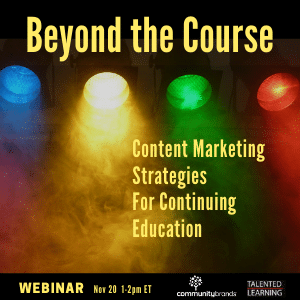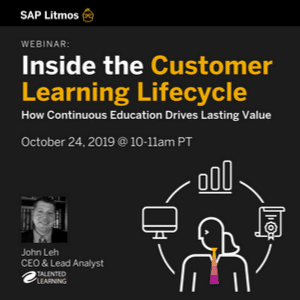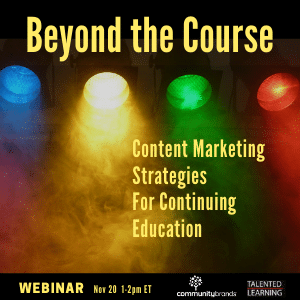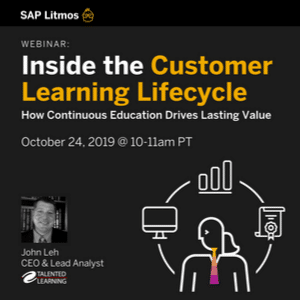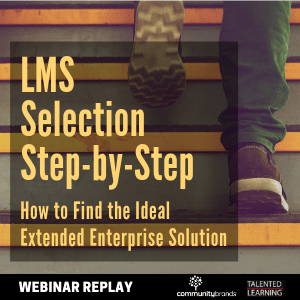WELCOME TO EPISODE 29 OF THE TALENTED LEARNING SHOW
To learn more about this podcast series or to see the full collection of episodes visit The Talented Learning Show main page.
EPISODE 29 – TOPIC SUMMARY AND GUEST:
Today we welcome Martijn Theuwissen, Co-Founder of DataCamp, a company devoted to making data science education accessible to all.
Martijn’s story is instructive for multiple reasons:
- He knows first-hand what it takes to grow a successful online training business.
- He works on the frontlines of the skills gap, helping individuals and employers prepare to compete in an increasingly data-driven economy.
- He’s committed to a broader mission – empowering people from all walks of life to develop data fluency.
I think you’ll agree, this interview offers useful advice for every learning professional.
KEY TAKEAWAYS:
- Demand for data science education is exploding, as organizations around the world strive to become more data-driven.
- In a fast-moving market like data science, online training providers can gain a competitive advantage by accelerating their content development speed.
- Other factors also contribute to the success of online training ventures. At DataCamp, those factors include a scalable business model, a smart technology strategy, high-quality instruction and customer feedback loops that drive continuous improvement.
Q&A HIGHLIGHTS:
Martijn, could you start by telling us about your background?
Sure. I’m from Belgium and I have a degree in finance and accounting. Actually, I have only one year of corporate experience, working in sales and marketing at The Coca-Cola Company.
But soon after I started at Coca-Cola, I discovered that I’m much better suited to an entrepreneurial environment than a large corporation. So, around six years ago, I co-founded DataCamp.
Wow. It took me 20 years to reach that point. What inspired you to go into online training?
Well, to be honest, it was a very lucky accident.
The best kind of accident…
Actually, multiple elements came into play:
- I’ve always had a passion for education. Since I was about 12 years old, I’ve been involved with student boards, student unions and education nonprofits.
- When I was looking for startup opportunities in 2014, my co-founder was teaching statistics at university.
- And coincidentally, that was the year of the MOOC (massively open online course), with platforms like edX and Coursera getting a lot of traction.
Right…
So, this combination of factors became the foundation of DataCamp:
- Our entrepreneurial drive
- Passion for improving data science education, and
- Interest in developing innovative technology.
Why did you specialize in data analytics?
Online training companies like Codecademy (programming skills) and Duolingo (language skills) were using digital technology to provide a better learning experience for specialized training.
So we decided to create something similar for statistics and data science because we understand that domain.
Mm-hmm…
We envisioned an environment where people get individualized feedback based on the mistakes they make while they’re actually typing in code. This provides a much more engaging learning experience with much higher completion rates.
Great. So how do you define data science?
Data science is basically everything involved with analyzing data.
There are many different definitions. But in my opinion, the moment you start playing around with data, you’re doing some form of data science. And by organizing and analyzing data effectively, you can make better decisions.
How big is the market for data science education?
These days, data is tracked and stored everywhere. Demand is growing very rapidly for people with data science skills who can analyze all of this available data. It touches every industry and function.
For example, HR professionals use machine learning to screen profiles when hiring. That requires data science expertise.
Or think of digital advertising platforms like Facebook or Google. They provide a bunch of data that you can analyze to optimize online marketing campaigns. This requires data fluency.
We’re also seeing an enormous uptick in consulting firms that play a key role in helping companies facilitate full-scale digital transformation.
How wide is the gap between the need for data science skills and the availability of competent people? Is that why so many consultancies are springing up?
Yeah, there is definitely a gap. In the past, data lived in the IT department. Now every department has access to a massive amount of data. But unfortunately, many business people don’t have enough knowledge to work with all the data that’s available to them.
In fact, about three years ago, McKinsey published an excellent study about the need for analytics talent. Even then, there was a shortage of 1.5 million data-savvy people.
Actually, everyone benefits from at least a basic level of data literacy. That’s why we like to say that data science skills are no longer only for data scientists. The same way that writing skills aren’t just for authors.
Good point. You talk a lot about the need to democratize data science. What do you mean by that?
It’s really about getting essential data skills in the hands of everyone who needs it. We’re trying to do this at a reasonable price point.
It’s also important for people to learn wherever and whenever they want – especially when they work full-time or have other commitments.
We want to empower everyone – students, employees and independent professionals – to develop basic data fluency or even the expertise to work as full-time data scientists.
Nice…
That’s important for business because data scientists are often located in their own department or in IT. This makes communication more difficult and creates bottlenecks when others need help from an analyst.
But if everyone has data science knowledge, you can dramatically improve communication. Also, when individuals across your organization are empowered to do their own basic analysis, your data scientists can focus on more complex issues.
So democratizing data science is beneficial for individuals, as well as their organizations.
How does your online training business help close that data skills gap?
DataCamp is a solution that helps anyone learn data science skills in an online interactive environment.
Our goal was to create a very engaging environment for people to develop the basic skills of data analytics and data science, over time. And since our launch in 2014, our customer base has grown to more than 4 million learners.
Impressive!
Yeah. Lots of people want to learn this. So we serve individuals as well as businesses. We started by focusing on individuals who use it to upskill or prepare for a career shift.
And lately, we’re seeing a lot of traction with enterprise businesses as well. Over 1500 B2B customers now use DataCamp, mostly to upskill or reskill their workforce.
Amazing. How did you grow to 4 million users in just 5 short years?
It’s been a wild journey. I think DataCamp’s success comes from a combination of things.
The timing was good. But it’s also the product, itself. We’ve focused on data science from the start, which created traction in our core community.
Makes sense…
We started with one language, which was R. That’s basically an open-source programming language used in data analysis.
Then we added more and more languages. Python. And then SQL. Now we even have courses without any coding requirements, such as fundamental data science courses and spreadsheet skills.
That kind of incremental expansion is a smart strategy…
We were lucky to start the company when data science was just beginning its massive growth. Plus, online training has been going through a significant transformation, itself. So we were there at the right time to scale.
Yep…
And every course is created by a team of internal and external subject matter experts. We now have more than 270 instructors, who are known and respected in their domain. That also draws people to our platform.
So those are the reasons why we’ve grown to more than 4 million learners in such a short time.
Outstanding! That’s great to get 270 industry experts to contribute as instructors.
Yes…
What about the content itself? How is it organized?
Our philosophy is, “Learn, practice, apply.” In other words, you:
- Learn with our courses
- Practice with repeatable exercises you can access through your mobile phone or on your desktop, and
- Apply with real-life projects you complete in the cloud.
What does this online training content look like? Do you integrate video? How do interactive elements work?
Each course takes around 4 hours to complete.
For every hour of content, there are about 15 minutes of passive learning through videos. That’s necessary because data science has such a strong mathematical foundation, and we’ve found that videos are the best way to explain those concepts.
During the other 45 minutes, you’re hands-on, doing interactive exercises. That’s because we believe in active learning.
So you’re typing in code at your keyboard. And if you make a mistake, you get relevant real-time feedback.
Excellent. You said that you have about 1500 B2B clients. Who’s your typical business buyer – IT departments or business units?
We see three primary scenarios:
- Data science departments that want advanced courses or are switching technologies.
- Business units – usually marketing or finance – that want to improve data-based decisions.
- Company-wide digital transformation initiatives to drive the shift toward a more data-literate culture. That’s when L&D folks come in.
Excellent. So how do you run this large-scale online training operation on the back end? Did you build your own learning management system?
We build everything in-house. Our platform is built to provide the best learning experience specifically for data science. That required us to start from scratch.
The technology we use for interactive feedback isn’t available anywhere else. That’s why we needed to develop it ourselves.
Interesting. How about content development? Is that also done with your own proprietary tools? Or do you use commercial solutions?
We built our own authoring environment, as well. That’s because we realized very quickly that speed in developing content is a major competitive advantage.
So although we have multiple teams focused on the learner experience, we also have a team focused on the instructor experience.
For example, how can we make it as easy as possible for an instructor to create an interactive course? That’s different from creating a video course.
They need to learn new technologies and embrace the unique pedagogical aspects of this process. So we developed the authoring environment to make it as easy as possible.
We also do the entire translation (for lack of a better word) to interactivity behind-the-scenes in an automatic way.
Wow. You might want to sell your platform to other verticals that may have a similar kind of need.
True.
So how did you convince 270 instructors to sign-up? How did you find them? And how do you compensate them? Everybody struggles with this…
Our model is similar to a book publisher. We have a wish list of courses we want to develop. Our curriculum team identifies courses we want to develop in the coming months. Then they start researching and contacting subject matter experts.
Our contracts are based on revenue sharing, where instructors are paid based on the number of times their course is completed. Not started, but completed. This way, there’s an incentive to create high-quality content that engages students from start to finish.
Great strategy. So do you ask them to follow a specific instructional model? Or do instructors bring their own approach and you adapt?
It’s a bit of both.
We ask our instructors to follow a framework. Because with so many courses, we want to make sure that they feel consistent and coherent for learners. So if you start one course on DataCamp, and then start a second course, both will have the same level of quality and engagement.
Our framework is based on a list of rules. For example, you can’t use more than 15 minutes of video in any one-hour of content. You can’t include too many multiple-choice questions. And so forth.
These rules tie back to our authoring interface, which automatically checks to verify that instructors are holding themselves to that framework. This makes the online training content development process fairly easy. And it gives authors various ways to be creative, as well.
Nice. So let’s talk about some real-world examples. How are corporations using data science education to improve their business…?
…FOR COMPLETE ANSWERS TO THIS QUESTION AND MORE, LISTEN TO THE FULL 30-MINUTE PODCAST!
WANT TO LEARN MORE? REPLAY THIS WEBINAR
Bridging the Learning Analytics Gap: How Guided Insights Lead to Better Results
Even with cutting-edge measurement tools, many struggle to find enough time and expertise to generate useful learning insights. How can you bridge this critical analytics gap?
Join John Leh, CEO and Lead Analyst at Talented Learning, and Tamer Ali, Co-Founder and Director at Authentic Learning Labs. You’ll discover:
- Top learning analytics challenges
- How AI-driven data visualization tools are transforming learning insights
- How to define and interpret relevant metrics
- Practical examples of AI-based analytics in action
- How to build a convincing case for guided analytics
REPLAY THE WEBINAR NOW!
Need Proven LMS Selection Guidance?
Looking for a learning platform that truly fits your organization’s needs? We’re here to help! Submit the form below to schedule a free preliminary consultation at your convenience.
The post Podcast 29: Growing an Online Training Business – With the Co-Founder of DataCamp appeared first on Talented Learning.
Podcast 29: Growing an Online Training Business – With the Co-Founder of DataCamp original post at Talented Learning

